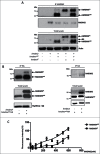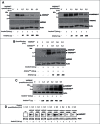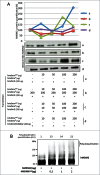The alternative translated MDMX(p60) isoform regulates MDM2 activity
- PMID: 25659040
- PMCID: PMC4615104
- DOI: 10.4161/15384101.2014.977081
The alternative translated MDMX(p60) isoform regulates MDM2 activity
Abstract
Isoforms derived from alternative splicing, mRNA translation initiation or promoter usage extend the functional repertoire of the p53, p63 and p73 genes family and of their regulators MDM2 and MDMX. Here we show cap-independent translation of an N-terminal truncated isoform of hMDMX, hMDMX(p60), which is initiated at the 7th AUG codon downstream of the initiation site for full length hMDMX(FL) at position +384. hMDMX(p60) lacks the p53 binding motif but retains the RING domain and interacts with hMDM2 and hMDMX(FL). hMDMX(p60) shows higher affinity for hMDM2, as compared to hMDMX(FL). In vitro data reveal a positive cooperative interaction between hMDMX(p60) and hMDM2 and in cellulo data show that low levels of hMDMX(p60) promote degradation of hMDM2 whereas higher levels stabilize hMDM2 and prevent hMDM2-mediated degradation of hMDMX(FL). These results describe a novel alternatively translated hMDMX isoform that exhibits unique regulatory activity toward hMDM2 autoubiquitination. The data illustrate how the N-terminus of hMDMX regulates its C-terminal RING domain and the hMDM2 activity.
Keywords: MDM2; MDMX; alternative translation; isoforms; protein stability.
Figures





Similar articles
-
Oncogenic functions of hMDMX in in vitro transformation of primary human fibroblasts and embryonic retinoblasts.Mol Cancer. 2011 Sep 12;10:111. doi: 10.1186/1476-4598-10-111. Mol Cancer. 2011. PMID: 21910853 Free PMC article.
-
p53 regulation: teamwork between RING domains of Mdm2 and MdmX.Cell Cycle. 2011 Dec 15;10(24):4225-9. doi: 10.4161/cc.10.24.18662. Epub 2011 Dec 15. Cell Cycle. 2011. PMID: 22134240 Review.
-
Mdm2 Splice isoforms regulate the p53/Mdm2/Mdm4 regulatory circuit via RING domain-mediated ubiquitination of p53 and Mdm4.Cell Cycle. 2017 Apr 3;16(7):660-664. doi: 10.1080/15384101.2017.1288327. Epub 2017 Feb 6. Cell Cycle. 2017. PMID: 28166445 Free PMC article.
-
The human oncoprotein MDM2 uses distinct strategies to inhibit transcriptional activation mediated by the wild-type p53 and its tumor-derived mutants.Int J Oncol. 2001 Mar;18(3):449-59. doi: 10.3892/ijo.18.3.449. Int J Oncol. 2001. PMID: 11179471
-
Alternative and aberrant splicing of MDM2 mRNA in human cancer.Cancer Cell. 2002 Jul;2(1):9-15. doi: 10.1016/s1535-6108(02)00091-0. Cancer Cell. 2002. PMID: 12150820 Review.
Cited by
-
Where does transcription start? 5'-RACE adapted to next-generation sequencing.Nucleic Acids Res. 2016 Apr 7;44(6):2628-45. doi: 10.1093/nar/gkv1328. Epub 2015 Nov 28. Nucleic Acids Res. 2016. PMID: 26615195 Free PMC article.
-
The long and the short of it: the MDM4 tail so far.J Mol Cell Biol. 2019 Mar 1;11(3):231-244. doi: 10.1093/jmcb/mjz007. J Mol Cell Biol. 2019. PMID: 30689920 Free PMC article. Review.
-
Cryptic in vitro ubiquitin ligase activity of HDMX towards p53 is probably regulated by an induced fit mechanism.Biosci Rep. 2022 Jul 29;42(7):BSR20220186. doi: 10.1042/BSR20220186. Biosci Rep. 2022. PMID: 35674210 Free PMC article.
-
MDM4 alternative splicing and implication in MDM4 targeted cancer therapies.Am J Cancer Res. 2021 Dec 15;11(12):5864-5880. eCollection 2021. Am J Cancer Res. 2021. PMID: 35018230 Free PMC article. Review.
-
Mdm2 and MdmX RING Domains Play Distinct Roles in the Regulation of p53 Responses: A Comparative Study of Mdm2 and MdmX RING Domains in U2OS Cells.Int J Mol Sci. 2020 Feb 15;21(4):1309. doi: 10.3390/ijms21041309. Int J Mol Sci. 2020. PMID: 32075226 Free PMC article.
References
-
- Blandino G, Dobbelstein M. p73 and p63: why do we still need them? Cell Cycle 2004; 3:886-94; PMID:15254416; http://dx.doi.org/10.4161/cc.3.7.996 - DOI - PubMed
-
- Levrero M, De Laurenzi V, Costanzo A, Gong J, Wang JY, Melino G. The p53/p63/p73 family of transcription factors: overlapping and distinct functions. J Cell Sci 2000; 113 (Pt 10):1661-70; PMID:10769197 - PubMed
-
- Dotsch V, Bernassola F, Coutandin D, Candi E, Melino G. p63 and p73, the ancestors of p53. Cold Spring Harbor Perspec Biol 2010; 2:a004887; PMID:20484388; http://dx.doi.org/10.1101/cshperspect.a004887 - DOI - PMC - PubMed
-
- Truong AB, Khavari PA. Control of keratinocyte proliferation and differentiation by p63. Cell Cycle 2007; 6:295-9; PMID:17264679; http://dx.doi.org/10.4161/cc.6.3.3753 - DOI - PubMed
-
- Murray-Zmijewski F, Lane DP, Bourdon JC. p53/p63/p73 isoforms: an orchestra of isoforms to harmonise cell differentiation and response to stress. Cell Death Differ 2006; 13:962-72; PMID:16601753; http://dx.doi.org/10.1038/sj.cdd.4401914 - DOI - PubMed
Publication types
MeSH terms
Substances
LinkOut - more resources
Full Text Sources
Other Literature Sources
Research Materials
Miscellaneous
